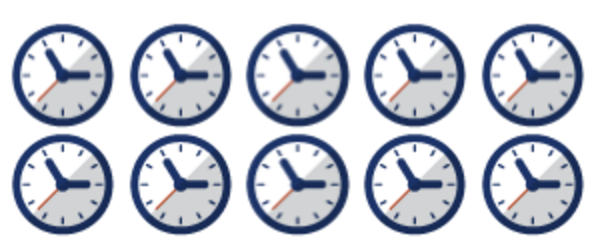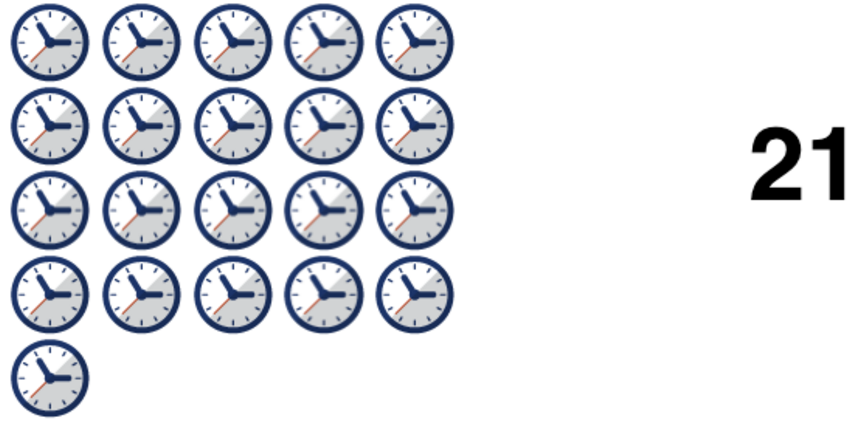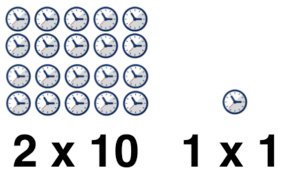Symbol to Represent Quantity
Lab: Basics of Digitizing Data
Video Runtime: 14:26
This episode continues our discussion on the Basics of Digitizing Data. In order to understand how computers work, first, you need to go back to your basic math. Let’s talk about the symbols we use to represent quantities. This episode is a quick overview of our counting system and Base-10 numbering system.
Your key takeaways are:
- Numbers and digits are the symbols used to represent a quantity
- Digits are the numbers 0 to 9
- The Decimal Number System is based on the quantities of 10
- Base-10 is expressed as 10 to the power of a factor of X
Study Notes
How do we represent the number of items?
Numbers are symbols which represent a count or quantity. We are putting emphasis on “symbol” and “representation.” Humankind created “numbers” as a form of global language.
Early Quantity Identification

- We have a certain number of items. These items are clocks.
- We want to identify the quantity of clocks by counting them.
- What did we use to count?
- We could use the 10 fingers on our hands to count. 1, 2, 3, 4….
The Symbol

- We need a way to communicate the quantity vs. counting on our fingers or showing pictures of the number of items.
- Let’s start by identifying the symbols we will use in this new language.
- We need to represent some number of counts on our fingers.
- Starting at the first finger, we assign the symbol: 1, 2, 3, 4, 5, 6, 7, 8, 9.
- How do we represent 10?
- Notice that each of the numbers is a single symbol.
- Do we use a two symbol representation of “10”?
- What if we used “0”? It’s a single symbol.
- Redoing our counting then, the first finger is 0, 1, 2, 3, 4, 5, 6, 7, 8, 9.
In the Decimal Number System, we use the symbols: 9, 8, 7, 6, 5, 4, 3, 2, 1, 0.
These symbols are called digits.
Per the Merriam-Webster dictionary, a digit is a noun that means:
- a written symbol for any of the numbers 0 to 9
- a finger or toe
Symbol to Represent Quantity

- 21 clocks
- We know that we write that symbol as two digits: 21
- What is the pattern?
What is the digit pattern?



You can break this down into patterns:
- How many times do you count 10 on your fingers? 2 times, or 2 counts of 10 clocks.
- What is remaining? There is 1 clock remaining.
- Now let’s formulate a mathematical expression.
- 2 counts of 10 is the same as 2 x 10.
- 1 remaining is the same as 1 x 1.
- We have a certain number of items. Here these items are clocks.
- We want to identify the quantity of clocks by counting them.
- Show how a decimal number is a symbol used to represent the quantity of something. Here, the symbols are clocks.
- Then, we begin breaking it down into positional notation.
- Convert that into base-10.
- If we have 2 x 10 then we can say that there are 2 tens.
- Using Base-10, “tens” is represented by 10 to the power of 1, as that equals 10.
- Therefore, we can say 2 x 101 which equals 20.
- If we have 1 x 1, then we can say there are 1 ones.
- Using Base-10, “ones” is represented by 10 to the power of 0, as that equals 1.
- Therefore, we can say 1 x 100 which equals 1.
- We just created a symbol set to represent 21 clocks.
Decimal Number System Base-10

Using base 10, we are able to represent very large or very small numbers.
We use numbers as symbols to represent a count (quantity.)
When was the last time you got out of your chair and stretched? Just saying…
Episodes
Total Lab Runtime: 02:59:07
- 1 Lab Introductionfree 03:56
- 2 Electronics “on” and “off” Statesfree 12:11
- 3 Symbol to Represent Quantityfree 14:26
- 4 Number System for Statefree 12:44
- 5 Binary – Combining 1s and 0sfree 19:25
- 6 Improving Binary Representationfree 13:45
- 7 The Age of 16 Bit and Hexadecimalfree 15:15
- 8 Binary Additionfree 03:59
- 9 Negative Integer Data Representation - Part 1free 10:06
- 10 Negative Integer Data Representation - Part 2free 18:42
- 11 Real Number Data Representation - Part 1free 17:12
- 12 Real Number Data Representation - Part 2free 10:18
- 13 Textual Data Representationfree 08:47
- 14 Digital Image Data Representationfree 18:21
